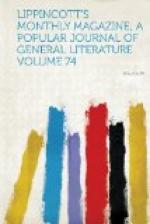In Cambridge, three miles from Boston, the eighteenth-century Episcopalians not only possessed a church, but also displayed to unwilling eyes a veritable “Bishop’s Palace”—the stately house of the Rev. East Apthorp, “missionary to New England” and reputed candidate for the bishopric of that region. Mr. Apthorp was rich and influential, but his social and ecclesiastical lot was not an easy one, and he soon returned to England discouraged, leaving his “palace” to come down to the view of our own eyes, which find in it nothing more dangerous to republican institutions than is to be discovered in a hundred other of the three-story wooden houses which used so to abound in Massachusetts. Christ Church, Cambridge, in which the bishop in posse used to minister, and which stands opposite Harvard College, was designed by the architect of King’s Chapel, and has always been praised for a certain shapely beauty of proportion. For the last twenty years it has boasted the only chime of bells in Cambridge, whose quiet shades of a Sunday evening have been sweetly stirred by the music struck from them by the hands of a worthy successor of the mediaeval bell-ringers, to whom bells are books, and who can tell the story of every ounce of bell-metal within twenty miles of his tower. It was of this church, with its Unitarian neighbor just across the ancient churchyard where so many old Harvard and colonial worthies sleep, that Holmes wrote:
Like sentinel and nun, they keep
Their vigil on the green:
One seems to guard, and one to weep,
The dead that lie between.
The suburbs of Boston are not poor in churches of the eighteenth, or even of the seventeenth, century. The oldest church in New England—the oldest, indeed, in the Northern States—still standing in Salem, was built in 1634, and its low walls and tiny-paned windows have shaken under the eloquence of Roger Williams. It has not been used for religious purposes since 1672. In Newburyport is one of the American churches, once many but now few, in which George Whitefield preached, and beneath it the great preacher lies buried. A curious little reminder of St. Paul’s, London, is found here in the shape of a whispering gallery. Another landmark is the venerable meeting-house of the Unitarian society in Hingham, popularly known as the “Old Ship.” Built in 1681, it was a Congregational place of worship for nearly a century and a half. Its sturdiness and rude beauty form a striking illustration of the lasting quality of good, sound wooden beams as material for the sanctuary. Preparations have already been undertaken for celebrating the second centennial of the ancient building. Nearly as old, and still more picturesque with its quaint roof, its venerable hanging chandelier of brass, its sober old reredos and its age-hallowed communion-service, is St. Michael’s, Marblehead, built in 1714, where faithful rectors have endeavored to reach six generations of the fishermen




